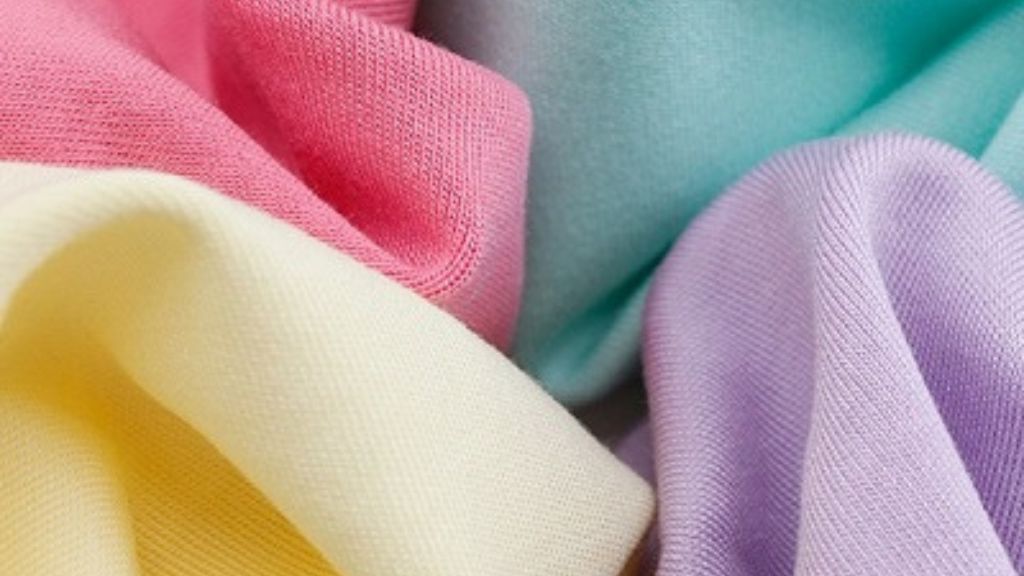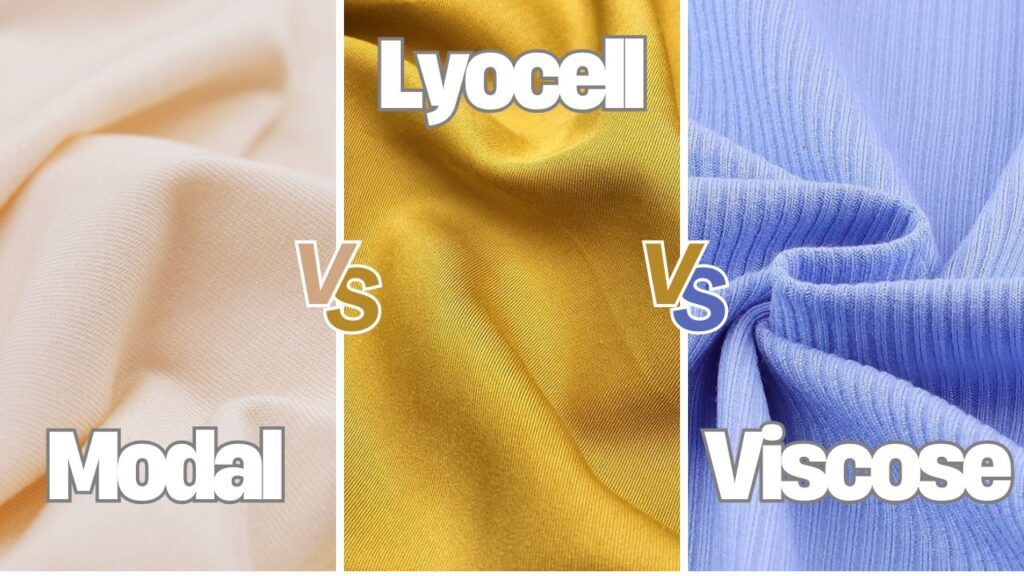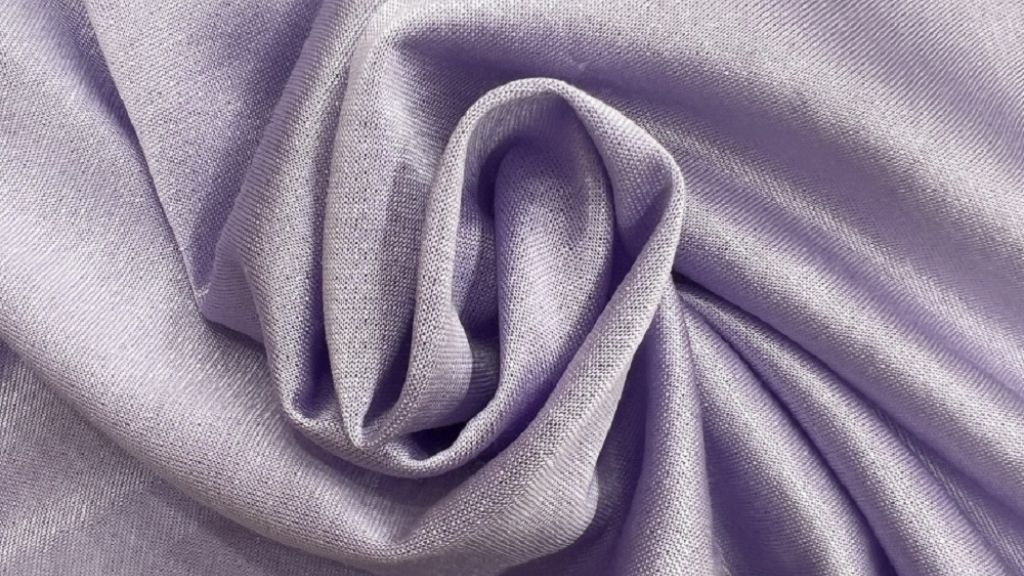Textile Fabric Guide: What is Modal Fabric?

Modal fabric, often associated with underwear, has gained popularity in recent years for its luxurious feel, softness, and sustainability. But what exactly is Modal fabric? Which Modal material is best for you? How to distinguish Modal from other semi-synthetic cellulose fibers like lyocell or viscose? In this guide, we’ll tell you everything you need to know about modal. Let’s get started!
What Is Modal Fabric?
Modal is a type of high-wet-modulus (HWM) regenerated cellulose fiber, developed in the 1950s by Lenzing Company to improve the properties of rayon. It is made from wood pulp, primarily found in spruce and beech trees. Through specialized spinning and weaving processes, Modal fibers can be crafted into soft and delicate fabrics.
Modal fabric is well known for its exceptional softness, luster, and drape. Its fiber fineness reaches 1 dtex, which is significantly finer than cotton (1.5–2.5 dtex) and close to silk (1.3 dtex). This ultra-fine structure gives it a soft hand feel and a naturally lustrous surface. Meanwhile, Modal also has excellent hygroscopicity, and its water absorption rate is about 50% higher than that of cotton. It is an ideal material for underwear, vests, leggings, pajamas and other close-fitting clothing.
How Is Modal Fabric Made?
As we mentioned before, Modal is made by extracting cellulose from spruce and beech wood pulp. The production process of Modal yarn generally includes 4 main stages: raw material processing, fiber preparation, fiber melting, and spinning.
Firstly, impurities and lignin in the wood need to be removed through a chemical treatment process to obtain pure cellulose. Then, the cellulose solution is formed into fibers through processes such as spraying, spinning, and stretching. Next, the fibers are softened at high temperatures and melted by airflow, transforming them into a gel-like state. Finally, the gel fibers are sent to a spinning machine to be spun into yarn, resulting in the finished yarn. After these processes, the yarns are interlaced at right angles to each other, forming a dense and strong fabric. That’s how Modal fabric is made.
What Does Modal Feel Like?
Modal fabric feels exceptionally soft and smooth, fitting comfortably like a “second skin”. Many people may have already purchased clothing made from modal, especially for items like underwear or sleepwear.
In terms of texture, modal is obviously softer and smoother than cotton, with a finish that is closer to silk. When worn, it drapes naturally and conforms to the body without feeling tight or restrictive. Additionally, Modal also has excellent breathability due to its loose fiber structure and strong air circulation, making it particularly suitable for hot summer days.
What are the Different Types of Modal Fabric?
Based on Process (Manufacturing Technique)
Micromodal Fabric: Micromodal is a finer and even softer version of traditional modal. Its fibers are thinner than regular modal fibers, making it extra soft and lightweight. Micromodal is often used in high-end lingerie, camisoles, underwear and loungewear due to its superior comfort and smooth texture.
Lenzing Modal Fabric: Produced by Lenzing AG, an Austrian company known for sustainable fiber production, Lenzing Modal is renowned for its softness, breathability, and durability. Its manufacturing process adopts a closed-loop system, which produces almost no harmful substances, and the wastewater can be recycled.
Based on Composition (Fiber Blends)
100% Modal Fabric: “100% Modal Fabric” which means it’s made entirely of modal fibers, without blending with other materials. This soft modal fabric is known for its soft, smooth and luxurious feel. It is often used to make bed sheets and pajamas, providing a comfortable and breathable experience.
Modal Cotton Fabric: Cotton Modal is a fabric blend of modal and cotton fibers, combining the breathability and comfort of cotton with the softness and luxury of modal. Commonly used in casual wear, shirts, and dresses, this blend offers the perfect balance between comfort and durability.
Modal Spandex Fabric: The most common Modal Spandex fabric is made of 95% Modal and 5% Spandex. It combines the softness of Modal with the stretch of Spandex, making it ideal for activewear, yoga pants, and form-fitting garments, providing comfort and freedom of movement without losing its shape.
Modal Tencel Fabric: A blend of Modal and Tencel (lyocell), this fabric is very suitable for making underwear. It is highly breathable and is an ideal choice for those seeking eco-friendly, comfortable and high-performance clothing.
Modal Rayon Fabric: Blended with other rayon types, this fabric is cost-effective while retaining modal’s softness. It enhances the fabric’s drape and sheen, making it suitable for fashionable garments such as dresses, shirts and skirts.
Pros And Cons Of Modal Fabric
Pros of Modal Fabric
Easy to Dye: Modal fabric can be easily dyed into various shades of color as needs, presenting clear patterns and vibrant, rich colors.
Soft and Skin-Friendly: Modal is incredibly soft and smooth to the touch. It combines the softness of cotton, the sheen of silk, and the smoothness of linen, providing a luxurious wearing experience.
Strong Moisture Absorption: Known for its high moisture-wicking ability, Modal is an excellent choice for hot and humid climates, keeping you dry and comfortable.
Good Breathability: Modal allows excellent air circulation. This enhances comfort in warm conditions, making it a great choice for underwear and activewear, as it prevents you from feeling too hot or sweaty for long periods.
Cons of Modal Fabric
Poor Abrasion Resistance: Modal is softer than cotton but tends to wear out faster, particularly in areas of high friction, such as the elbows or knees. It’s less durable compared to other fabrics.
Prone to Pilling: Like many soft fabrics, modal can develop pills (small balls of fiber) over time, especially after repeated washing. This can affect its smooth appearance and make it look worn out prematurely.
Weak Wrinkle Resistance: Modal wrinkles more easily than some fabrics. It may require more care or ironing to maintain a smooth appearance.
Higher Cost: Modal can be more expensive compared to other fabrics, such as cotton and poly. While it offers superior comfort and durability, the price may be a factor for consumers looking for more affordable options.
What are the Differences between Modal and Other Semi-synthetic Cellulose Fibers?
Modal vs Lyocell
Lyocell, also known as Tencel, combines the best properties of both natural and synthetic fibers. It has a natural luster, smooth feel, and high strength, which makes it resistant to shrinking and durable.
Modal is produced through a modified viscose process, which gives it exceptional softness, a silk-like sheen, and excellent moisture absorption. It’s generally less durable than Lyocell, especially when wet, and has a more delicate feel.
Lyocell, on the other hand, is made using a closed-loop process, making it stronger, more resilient, and eco-friendly. Lyocell is less prone to shrinkage and has a more matte finish, but it’s not as soft and silky as Modal.
Modal vs Viscose
Viscose, also known as rayon, has good moisture wicking properties and feels comfortable against the skin. However, its wet modulus is relatively low, meaning it shrinks significantly and tends to lose shape after washing.
Modal is a more refined version of viscose, with a softer feel, better color retention, and superior moisture-wicking properties. It’s also stronger and more durable than regular viscose and has a better drape and silk-like sheen.
Viscose is made using a more basic process and is generally less durable than Modal. It tends to be more affordable but is more prone to shrinkage and wrinkling. Viscose is softer than cotton but doesn’t offer the same luxurious hand feel or strength as Modal.

How to Care for Modal Fabric?
Washing: When washing modal, avoid using hot water. It’s best to use water temperatures below 30°C to prevent damage to the fiber structure, which could lead to shrinkage or distortion. Please choose neutral detergent for washing. Avoid using strong alkaline soaps or bleach, as they will damage the softness of the fabric and cause fading. Hand washing is recommended, but if using a washing machine, opt for the gentle cycle and turn the garment inside out to reduce friction and prevent pilling.
Drying: Avoid direct sunlight, as prolonged exposure to sunlight can cause the fabric’s color to fade more easily. Instead, hang your clothes in a well-ventilated, shaded area. To maintain the fabric’s shape, lay it flat or use a wide-shouldered hanger. Avoid using narrow or thin hangers, which can stretch the fabric.
Ironing: If ironing is necessary, please use low heat. Iron your modal while it’s slightly damp, or use steam to help smooth out wrinkles without damaging the fibers.
Storing: Please fold modal garments neatly and store them in a dry, cool place. Avoid storing them in damp environments, as this may cause mold growth. Keep modal fabrics away from sharp objects, like metal jewelry, to prevent snags or pulls in the fabric.
Avoid Fabric Softeners: Softeners leave a residue on fibers that can affect the breathability and moisture-wicking properties of the fabric over time. Therefore, it’s best not to use it.
FAQ:
Q1: Is Modal Fabric Toxic?
A1: No, modal is not toxic. It’s made from sustainably sourced wood pulp and produced using an eco-friendly, closed-loop process.
Q2: Is Modal Fabric Good for Skin?
A2: Yes, modal is soft, smooth, breathable and gentle on sensitive skin.
Q3: Does Modal Shrink When Washed?
A3: Modal can shrink slightly if washed at high temperatures. To prevent this, wash in cold water and air-dry or use low heat.
Q4: Is Modal Fabric Good for Summer?
A4: Yes, modal is an excellent choice for summer clothing. It is breathable, moisture-wicking, and lightweight, which makes it ideal for keeping cool and comfortable in hot weather.
Q5: Which is Better, Modal or Cotton?
A5: Modal is softer, more breathable, and more absorbent than cotton. However, cotton is more durable and less prone to pilling. Cotton fabric is also cheaper and more readily available. In short, Modal textile suits premium, skin-friendly underwear, while Cotton textile is better for rugged, everyday wear.
Working With Facto Textile
We promise you:
- A wide variety of high- quality fabrics
- Full range of customized services
- Professional production technology
- Sincere Cooperation
Contact Us To Start Your Fabric Project
Please send us your message, we will reply within 20 hours.

